Presynaptic monoacylglycerol lipase activity determines basal endocannabinoid tone and terminates retrograde endocannabinoid signaling in the hippocampus
- PMID: 17267577
- PMCID: PMC6673197
- DOI: 10.1523/JNEUROSCI.4159-06.2007
Presynaptic monoacylglycerol lipase activity determines basal endocannabinoid tone and terminates retrograde endocannabinoid signaling in the hippocampus
Abstract
Endocannabinoids function as retrograde messengers and modulate synaptic transmission through presynaptic cannabinoid CB1 receptors. The magnitude and time course of endocannabinoid signaling are thought to depend on the balance between the production and degradation of endocannabinoids. The major endocannabinoid 2-arachidonoylglycerol (2-AG) is hydrolyzed by monoacylglycerol lipase (MGL), which is shown to be localized at axon terminals. In the present study, we investigated how MGL regulates endocannabinoid signaling and influences synaptic transmission in the hippocampus. We found that MGL inhibitors, methyl arachidonoyl fluorophosphonate and arachidonoyl trifluoromethylketone, caused a gradual suppression of cannabinoid-sensitive IPSCs in cultured hippocampal neurons. This suppression was reversed by blocking CB1 receptors and was attenuated by inhibiting 2-AG synthesis, indicating that MGL scavenges constitutively released 2-AG. We also found that the MGL inhibitors significantly prolonged the suppression of both IPSCs and EPSCs induced by exogenous 2-AG and depolarization-induced suppression of inhibition/excitation, a phenomenon known to be mediated by retrograde endocannabinoid signaling. In contrast, inhibitors of other endocannabinoid hydrolyzing enzymes, fatty acid amide hydrolase and cyclooxygenase-2, had no effect on the 2-AG-induced IPSC suppression. These results strongly suggest that presynaptic MGL not only hydrolyzes 2-AG released from activated postsynaptic neurons but also contributes to degradation of constitutively produced 2-AG and prevention of its accumulation around presynaptic terminals. Thus, the MGL activity determines basal endocannabinoid tone and terminates retrograde endocannabinoid signaling in the hippocampus.
Figures
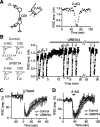
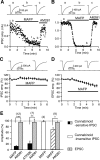
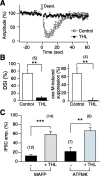
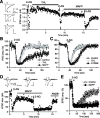
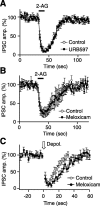


Similar articles
-
Monoacylglycerol lipase limits the duration of endocannabinoid-mediated depolarization-induced suppression of excitation in autaptic hippocampal neurons.Mol Pharmacol. 2009 Dec;76(6):1220-7. doi: 10.1124/mol.109.059030. Epub 2009 Sep 18. Mol Pharmacol. 2009. PMID: 19767452 Free PMC article.
-
Multiple Forms of Endocannabinoid and Endovanilloid Signaling Regulate the Tonic Control of GABA Release.J Neurosci. 2015 Jul 8;35(27):10039-57. doi: 10.1523/JNEUROSCI.4112-14.2015. J Neurosci. 2015. PMID: 26157003 Free PMC article.
-
Synapse type-independent degradation of the endocannabinoid 2-arachidonoylglycerol after retrograde synaptic suppression.Proc Natl Acad Sci U S A. 2012 Jul 24;109(30):12195-200. doi: 10.1073/pnas.1204404109. Epub 2012 Jul 10. Proc Natl Acad Sci U S A. 2012. PMID: 22783023 Free PMC article.
-
The serine hydrolases MAGL, ABHD6 and ABHD12 as guardians of 2-arachidonoylglycerol signalling through cannabinoid receptors.Acta Physiol (Oxf). 2012 Feb;204(2):267-76. doi: 10.1111/j.1748-1716.2011.02280.x. Epub 2011 Apr 22. Acta Physiol (Oxf). 2012. PMID: 21418147 Free PMC article. Review.
-
Endocannabinoids and synaptic function in the CNS.Neuroscientist. 2007 Apr;13(2):127-37. doi: 10.1177/1073858406296716. Neuroscientist. 2007. PMID: 17404373 Review.
Cited by
-
A biophysical model of endocannabinoid-mediated short term depression in hippocampal inhibition.PLoS One. 2013;8(3):e58926. doi: 10.1371/journal.pone.0058926. Epub 2013 Mar 18. PLoS One. 2013. PMID: 23527052 Free PMC article.
-
Druggable Targets in Endocannabinoid Signaling.Adv Exp Med Biol. 2020;1274:177-201. doi: 10.1007/978-3-030-50621-6_8. Adv Exp Med Biol. 2020. PMID: 32894511 Free PMC article. Review.
-
Involvement of nitric oxide in depolarization-induced suppression of inhibition in hippocampal pyramidal cells during activation of cholinergic receptors.J Neurosci. 2007 Sep 19;27(38):10211-22. doi: 10.1523/JNEUROSCI.2104-07.2007. J Neurosci. 2007. PMID: 17881527 Free PMC article.
-
The initiation of synaptic 2-AG mobilization requires both an increased supply of diacylglycerol precursor and increased postsynaptic calcium.Neuropharmacology. 2015 Apr;91:57-62. doi: 10.1016/j.neuropharm.2014.11.026. Epub 2014 Dec 4. Neuropharmacology. 2015. PMID: 25484252 Free PMC article.
-
Complementary synaptic distribution of enzymes responsible for synthesis and inactivation of the endocannabinoid 2-arachidonoylglycerol in the human hippocampus.Neuroscience. 2011 Feb 3;174:50-63. doi: 10.1016/j.neuroscience.2010.10.062. Epub 2010 Oct 28. Neuroscience. 2011. PMID: 21035522 Free PMC article.
References
-
- Alger BE. Retrograde signaling in the regulation of synaptic transmission: focus on endocannabinoids. Prog Neurobiol. 2002;68:247–286. - PubMed
-
- Bisogno T, Howell F, Williams G, Minassi A, Cascio MG, Ligresti A, Matias I, Schiano-Moriello A, Paul P, Williams EJ, Gangadharan U, Hobbs C, Di Marzo V, Doherty P. Cloning of the first sn1-DAG lipases points to the spatial and temporal regulation of endocannabinoid signaling in the brain. J Cell Biol. 2003;163:463–468. - PMC - PubMed
-
- Chevaleyre V, Castillo PE. Heterosynaptic LTD of hippocampal GABAergic synapses: a novel role of endocannabinoids in regulating excitability. Neuron. 2003;38:461–472. - PubMed
-
- Chevaleyre V, Takahashi KA, Castillo PE. Endocannabinoid-mediated synaptic plasticity in the CNS. Annu Rev Neurosci. 2006;29:37–76. - PubMed
-
- Cravatt BF, Giang DK, Mayfield SP, Boger DL, Lerner RA, Gilula NB. Molecular characterization of an enzyme that degrades neuromodulatory fatty-acid amides. Nature. 1996;384:83–87. - PubMed
Publication types
MeSH terms
Substances
LinkOut - more resources
Full Text Sources
Research Materials
